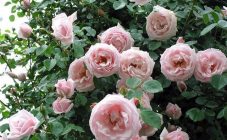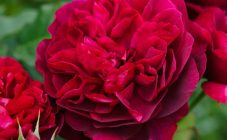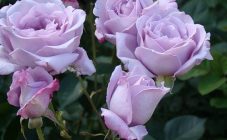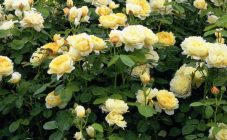Content:
It has long been tacitly recognized that the rose is the queen of flowers. Representative of the Shipovnikov family. The variety of these colors is simply amazing. They differ in color of buds, smell, bush shape. They can be spreading, pyramidal, whip-like. These shrubs look great in solo or group plantings.
All roses are classified according to their appearance and growing principles. Experienced growers conditionally divide all roses into 9 groups. One of them is floribunda, which has a long flowering time, excellent winter hardiness, many colors and aromas.
This flower was bred by a breeder from Denmark - Poulsen. He crossed a dwarf polyanthus rose with hybrid tea varieties of this flower. The result is the durability of the first type, the exquisite beauty and aroma of the second. The flowers turned out to be very large (heredity of the tea rose). Bushes with a height of 30 cm to 1 m bloom very abundantly and for a long time.
Moreover, the flowers on the bush do not grow singly, but in groups. Also, this rose is very winter-hardy and has good immunity to various diseases. There are undersized varieties in this group, they are called patios. Their height does not exceed half a meter. They are grown most often in containers, less often as a curb plant.
Rose Heidi Klum: description
A large number of varieties of this group have been created, which are successfully grown in our climate. One of them is the Heidi Klum Rose. This variety was bred in the German nursery "Tantau" in 1999. It has large double flowers, the shade of which can be dark lilac or dark purple (the color depends on the acidity of the soil). A little later, the color of the petals becomes richer, brighter, and then acquires a slightly silvery hue, a kind of noble gray hair. Flowers are collected in clusters of 3-5 pcs. Their delicate rich aroma, with notes of apricot and cinnamon, will charm any skeptic, moreover, it is not lost during the entire flowering. From the floribunda rose, this species inherited the lush green foliage.
This beauty combines compactness (bushes grow no more than 60 cm, their width is no more than 30 cm) and long flowering (flowers last for about 10 days) from a floribunda rose, and the size of a flower from a hybrid tea rose (size can reach up to 12 cm). At least once, having seen the Heidi Klum floribunda rose, it is impossible to forget its magnificence, sophistication and charm.
Location
Roses prefer sunny locations. Heidi Klum's rose is no exception. They will not be offended by a light partial shade, but not throughout the day. This flower is not afraid of rain, but in extreme heat it does not bloom. It is better to choose the soil moist, with good drainage, since what the rose does not like is stagnant water. Groundwater should be at least one meter.
This rose feels great in flowerpots on the terrace, balcony and windowsill.
Care
For better flowering, any culture needs fertilizer, but this rose is not very whimsical here. From early spring to mid-summer, she needs nitrogen, and from mid-summer to autumn, she needs potassium and phosphorus. Fertilizers must be applied both during the flowering period and at the end of it, so that the bush leaves with a reserve of strength in the winter. Watering is necessary in moderation, but regular. It is best to cover for the winter period.
So that the bush does not lose its attractiveness, it must be cut several times per season. It is also necessary to promptly remove dry, diseased and damaged branches. Faded flowers must also be removed. In addition to decorative properties, pruning is needed to prevent fungus.
This plant blooms in our region in two waves, that is, this species is remontant. After the plant has bloomed for the first time, all flowers must be removed. This is done so that no fruits are formed. The flower spends a lot of energy and nutrients on them, so necessary for the second wave of flowering. A faded flower is removed with buds above the flower, as well as with leaves below it. This stimulates the formation of new shoots and even more flowers. After such pruning, the plant must be fed immediately.
The last pruning is done in the fall. Remove all broken branches and those that interfere with the neat and high-quality shelter of the bush for the winter. In the spring, pruning is done again, leaving 3-4 strong, well-developed buds.
Thus, the landing rules can be summarized:
- it is better to grow this rose in a container way or creating small groups in flower beds;
- the place must be chosen on fertile soils without drafts, light, but constant sun rays are not welcome - a light partial shade is better;
- in the year of planting, it will be more correct not to allow active flowering, it is better to remove flowers;
- this beauty does not require much care: timely watering, loosening, weeding, feeding and pruning.
Heidi Klum on the trunk
This miniature bush on the trunk looks very picturesque. In addition, the ventilation of such a plant is better, therefore, it will be less affected by various diseases (such as fungi and rot, black leaf spot and powdery mildew).
The difference when planting a rose on a stem and just a rose is that a wooden pole must be hammered into the center of the planting pit (best of all, bamboo, it does not rot), with a height equal to the height of the stem. Tie the stem to the peg. Caring for a standard rose is no more difficult than a simple one:
- during the summer, it is necessary to remove the growth on the trunk and its base;
- cut the crown into a bowl;
- water in a timely manner;
- make top dressing;
- loosen, mulch the soil;
- insulate for the winter.
Leaving the bole uninsulated for the winter is not recommended. Therefore, even during landing, it will be necessary to take into account which side the tilt will be. The bend that is at the root collar must be positioned on the opposite side so that the shoot does not break off at the fusion point. It is necessary to plant so that this place is in the ground. In the fall, it is necessary to dig the soil at the root collar about the floor of a shovel bayonet, untie the stem and tilt it to the intended side. Until frost comes, the trunks can be easily bent where necessary and secured with a bracket.
So that the vaccination site does not break, it is covered with small boards or chips and covered with earth. A not thick log should be placed under the trunk so that the stem does not come into contact with the ground. The place of the fold must be insulated with dry grass, straw, or spruce branches. Wire frames are installed on top of the entire bent plant. A covering material or burlap is pulled over the frame, and over it with a film. And then the snow will cover them with its warm blanket.
As soon as the sun begins to warm in the spring, the roses must begin to air. And a little later, remove the film altogether, leaving the lower shelter. Otherwise, the buds will already begin to bloom, but the roots are not working yet. And the plant can dry out.
Reproduction
These roses reproduce only vegetatively.The easiest way is grafting. It is best to select cuttings after the first wave of flowering.
Advantages and disadvantages
Rose Heidi Klum has a lot of advantages. This and:
- abundant flowering;
- exquisite aroma;
- large, beautiful flowers;
- good winter hardiness;
- good disease resistance;
- she is not afraid of rain.
The disadvantages include:
- short stature;
- sometimes flowers bloom for only a few days;
- does not bloom in the heat.
This species has been at the peak of popularity for two decades. Increasingly, gardeners prefer this proud beauty, truly a queen. Indeed, in order to fully enjoy its beauty and aroma, very often you have to kneel before it.















